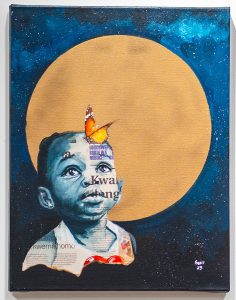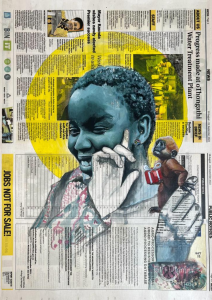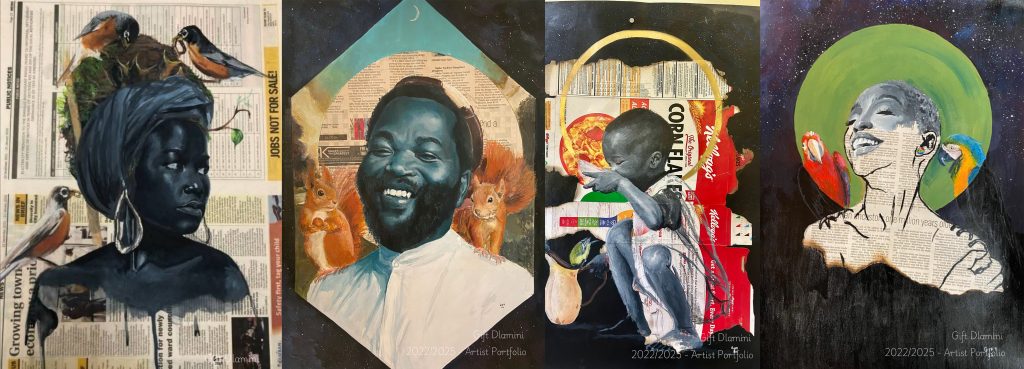In the heart of KwaMashu, where the pulse of township life beats in rhythm with Zulu drums and everyday survival, a young boy discovered that art was more than a skill — it was a calling. For Gift Dlamini, a South African fine artist and proud descendant of the Zulu clan, creativity did not arrive as a hobby or a choice. It emerged as a natural language he was born with, a spiritual inheritance he believes was bestowed upon him by both his ancestors and God.
“My journey into art didn’t begin in a studio,” he reflects. “It began in my spirit — a feeling that I had something to express long before I understood how important it would become.”
Early Beginnings: A Talent Takes Root

Dlamini’s artistic journey took shape at the age of fourteen while studying at Mzuvele High School, where his love for drawing and illustration began to flourish. What started as sketching in schoolbooks soon grew into a deep passion, one that anchored him during the challenges of township life. He later pursued formal studies at eThekwini College, further developing what he already felt was part of his identity rather than a learned profession.
“I didn’t choose art,” he says. “Art chose me. It became the way I speak when words aren’t enough.”
KwaMashu: A Place of Contrast, Culture, and Calling
Growing up in KwaMashu, north of Durban, meant navigating both cultural richness and economic challenges. For Dlamini, KwaMashu was a place where ancestral traditions coexisted with modern struggles — and his work reflects that tension. The township’s stories, rhythms, resilience, and spiritual undertones shaped his perspective and formed the emotional backbone of his visual language.
His paintings evolved into a form of social and spiritual commentary, exploring themes of identity, fear, resilience, ancestral guidance, and social justice. Each brushstroke became a conversation between the seen and unseen, between present reality and ancestral echoes.
Newspaper as Canvas: Turning Limitation into Legacy

Unable to afford traditional canvas or professional paper in the early stages of his career, Dlamini turned to what was available — newspaper. What began as a necessity transformed into a distinctive artistic signature.
The printed words and headlines beneath his paint became part of the narrative, grounding his spiritual and metaphorical imagery in the physical realities of everyday life. In his work, the past, present, and future merge — each layer carrying emotional weight and cultural storylines.
“The newspaper carries the world’s stories,” he explains. “When I paint on it, I’m adding my own voice to those global conversations.”
Themes of Spirit, Struggle, and Self
Dlamini’s art reflects the complexities of African identity in a rapidly changing world. His paintings often depict the quiet presence of ancestors, the emotional struggles of human experience, and the ongoing battle for direction in uncertain times. His work calls viewers into spaces of reflection — about who they are, where they come from, and what guides them forward.
Vision Beyond the Township
Though his journey is rooted in KwaMashu, Dlamini’s vision reaches far beyond it. He dreams of seeing his work showcased not only in local galleries but on international stages, representing the spirit of young African artists who rise despite limitations.
He acknowledges that building a career as an artist can be difficult, especially in spaces where creative industries are still growing. But his passion fuels his persistence.
“Being an artist doesn’t always generate immediate financial success,” he reflects, “but with passion and drive, I know my voice will continue to grow.”
Exhibitions and the Road Ahead
Today, his work is showcased at The Gallery, where selected exhibitions offer audiences a closer look at his storytelling — layered, emotional, and unapologetically African. Each exhibition serves as both a celebration and a reminder: that art born from struggle can radiate power, hope, and identity.
A Legacy in the Making

For Gift Dlamini, art is not just a career — it is a map of where he has been, a prayer for where he is going, and a bridge for others who see themselves in his story. His journey is a testimony to how limitation can become legacy, how culture can become canvas, and how a boy from KwaMashu can speak to the world through paint and paper.
Social media @GIFTDLAMINIARTIST @Gift Dlamini sa



